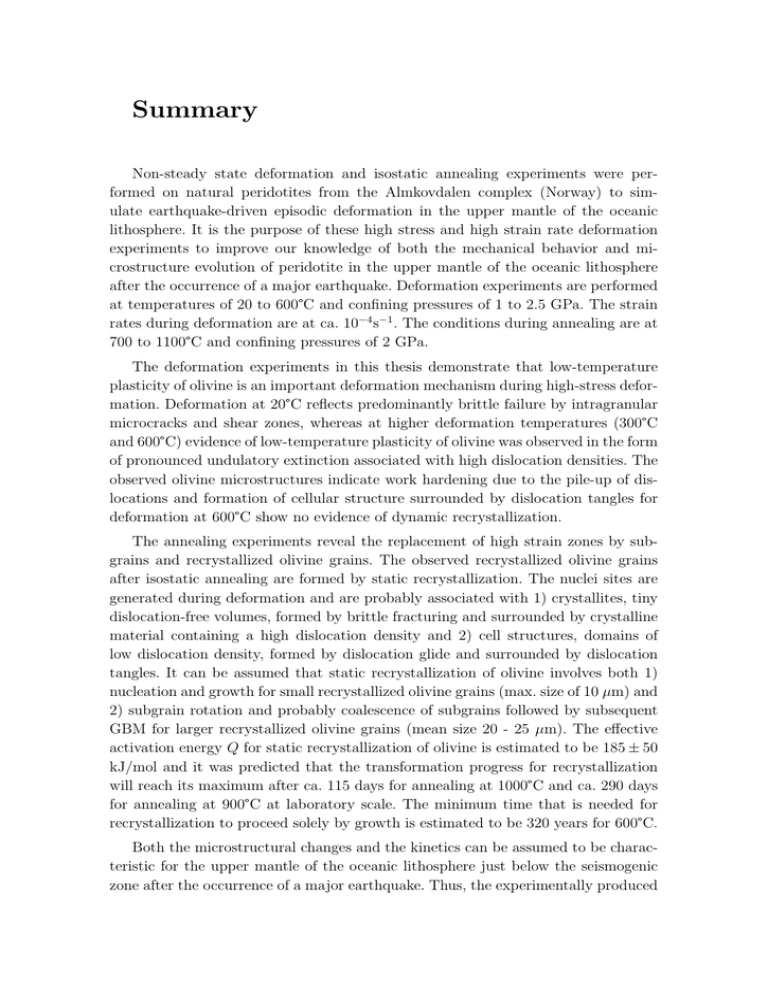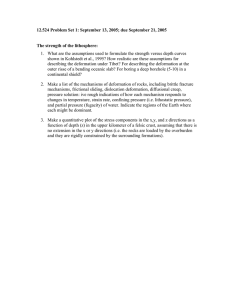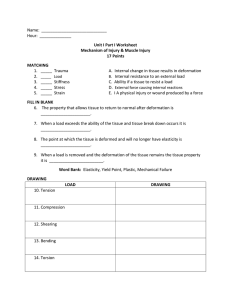Experimental high-stress deformation and annealing of peridotite
advertisement

Summary Non-steady state deformation and isostatic annealing experiments were performed on natural peridotites from the Almkovdalen complex (Norway) to simulate earthquake-driven episodic deformation in the upper mantle of the oceanic lithosphere. It is the purpose of these high stress and high strain rate deformation experiments to improve our knowledge of both the mechanical behavior and microstructure evolution of peridotite in the upper mantle of the oceanic lithosphere after the occurrence of a major earthquake. Deformation experiments are performed at temperatures of 20 to 600°C and confining pressures of 1 to 2.5 GPa. The strain rates during deformation are at ca. 10−4 s−1 . The conditions during annealing are at 700 to 1100°C and confining pressures of 2 GPa. The deformation experiments in this thesis demonstrate that low-temperature plasticity of olivine is an important deformation mechanism during high-stress deformation. Deformation at 20°C reflects predominantly brittle failure by intragranular microcracks and shear zones, whereas at higher deformation temperatures (300°C and 600°C) evidence of low-temperature plasticity of olivine was observed in the form of pronounced undulatory extinction associated with high dislocation densities. The observed olivine microstructures indicate work hardening due to the pile-up of dislocations and formation of cellular structure surrounded by dislocation tangles for deformation at 600°C show no evidence of dynamic recrystallization. The annealing experiments reveal the replacement of high strain zones by subgrains and recrystallized olivine grains. The observed recrystallized olivine grains after isostatic annealing are formed by static recrystallization. The nuclei sites are generated during deformation and are probably associated with 1) crystallites, tiny dislocation-free volumes, formed by brittle fracturing and surrounded by crystalline material containing a high dislocation density and 2) cell structures, domains of low dislocation density, formed by dislocation glide and surrounded by dislocation tangles. It can be assumed that static recrystallization of olivine involves both 1) nucleation and growth for small recrystallized olivine grains (max. size of 10 µm) and 2) subgrain rotation and probably coalescence of subgrains followed by subsequent GBM for larger recrystallized olivine grains (mean size 20 - 25 µm). The effective activation energy Q for static recrystallization of olivine is estimated to be 185 ± 50 kJ/mol and it was predicted that the transformation progress for recrystallization will reach its maximum after ca. 115 days for annealing at 1000°C and ca. 290 days for annealing at 900°C at laboratory scale. The minimum time that is needed for recrystallization to proceed solely by growth is estimated to be 320 years for 600°C. Both the microstructural changes and the kinetics can be assumed to be characteristic for the upper mantle of the oceanic lithosphere just below the seismogenic zone after the occurrence of a major earthquake. Thus, the experimentally produced microfabrics allow us to indentify similar processes and conditions in exhumed rocks. The resemblance between microfabrics of experimentally and naturally deformed peridotites demonstrates the importance of low temperature plasticity in combination with subsequent recrystallization of olivine during annealing at low stresses at lithospheric conditions related in particular to seismic activity in the mantle. Nonsteady state deformation with subsequent annealing of the peridotites produced ”core-and-mantle” like structures often interpreted as imprint of steady-state dislocation creep. In this case, paleopiezometers are not applicable and a local CPO in aggregates of new grains does not necessarily indicate the activated glide system.




